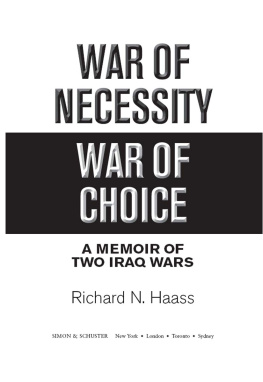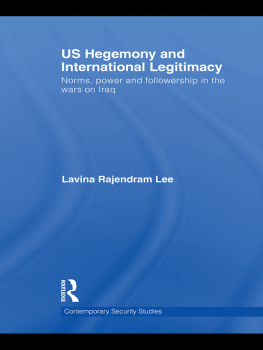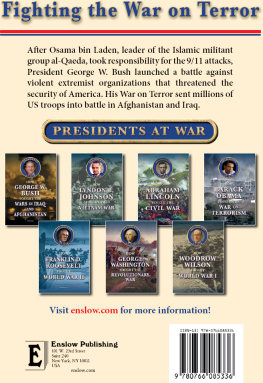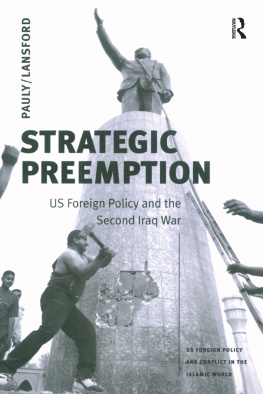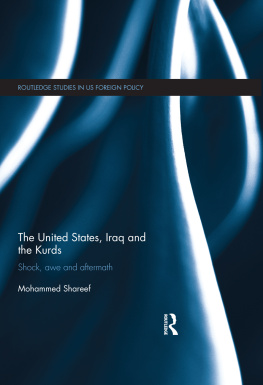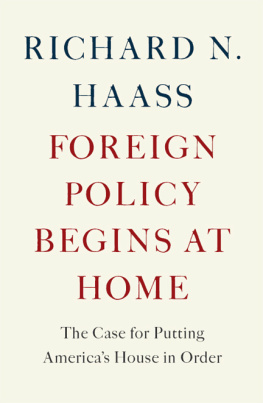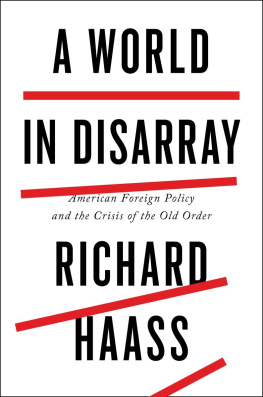ALSO BY RICHARD N. HAASS
The Opportunity:
Americas Moment to Alter Historys Course
The Reluctant Sheriff:
The United States After the Cold War
The Bureaucratic Entrepreneur:
How to Be Effective in Any Unruly Organization (initially published as The Power to Persuade: How to Be Effective in Any Unruly Organization)
Intervention:
The Use of American Military Force in the PostCold War World
Conflicts Unending:
The United States and Regional Disputes
Beyond the INF Treaty:
Arms, Arms Control, and the Atlantic Alliance
Congressional Power:
Implications for American Security Policy
EDITED VOLUMES
Honey and Vinegar:
Incentives, Sanctions, and Foreign Policy
(co-edited with Meghan OSullivan)
Transatlantic Tensions:
The United States, Europe, and Problem Countries
Economic Sanctions and American Diplomacy
Superpower Arms Control: Setting the Record Straight
(co-edited with Albert Carnesale)

SIMON & SCHUSTER
1230 Avenue of the Americas
New York, NY 10020
Copyright 2009 by Richard N. Haass
All rights reserved, including the right to reproduce this book or portions thereof in any form whatsoever. For information address Simon & Schuster Subsidiary Rights Department, 1230 Avenue of the Americas, New York, NY 10020.
SIMON & SCHUSTER and colophon are registered trademarks of Simon & Schuster, Inc.
Library of Congress Cataloging-in-Publication Data
Haass, Richard
War of necessity: war of choice / by Richard N. Haass.
p. cm.
1. Iraq War, 2003Causes. 2. Iraq War, 2003Political aspects. 3. Bush, George W. (George Walker), 1946Political and social views. 4. Persian Gulf War, 1991Causes. 5. Persian Gulf War, 1991Political aspects. 6. Bush, George, 1926Political and social views. 7. United StatesPolitics and government1989 8. United StatesForeign relationsMiddle East. 9. Middle EastForeign relationsUnited States. 10. United StatesMilitary policy. I. Title.
DS79.764.U6H337 2009
956.7044'3dc22 2009004495
ISBN13: 978-1-4391-6570-6
ISBN10: 1-4391-6570-X
Visit us on the World Wide Web:
http://www.SimonandSchuster.com
To the Men and Women of the U.S. Armed Forces
who served in the two Iraq conflicts and to
Frederick C. Smith, who for thirty years has been all
that anyone could ask for in a friend
CONTENTS
WAR OF NECESSITY WAR OF CHOICE
1. A TALE OF TWO WARS
FOR TWO WEEKS, the U.S. intelligence community had monitored the gradual buildup of Iraqs armed forces along its southern border with Kuwait. The prevailing view within the administration of George H. W. Bush was that Iraqi military activity constituted a crude attempt to bludgeon Kuwaitoil rich, loaded with cash, and widely resented for the arrogance often displayed by its leadersinto lowering its oil output and dropping its objection to a higher price for the precious commodity. It was a view that I shared, much to the consternation of Charlie Allen, the crusty, veteran national intelligence officer for warning, who was convinced before anyone else that the Iraqis were not bluffing.
By August 1, 1990, however, it had become clear to all of us working on the issue that what we were seeing unfold was a good deal more than simply another act in the long-running theater of Arab diplomacy. Iraq had amassed too many troops and was doing too many of the things it would have to do if it were actually going to attack Kuwait rather than just threaten it. The Central Intelligence Agency issued an alert that predicted an attack was imminent. A special meeting of the deputies (the subcabinet group of senior officials representing the principal departments and agencies most involved in foreign and defense policy) was convened in one of the seventh-floor conference rooms at the State Department to discuss what was known and what the United States might do about it. It being August, many of the most senior people were away, escaping Washingtons notorious heat and humidity. Secretary of State James Baker was off meeting in Siberia with his Soviet counterpart and was scheduled to go to Mongolia; Larry Eagleburger, his deputy, was taking the day off. Bob Kimmitt, normally the number three person at State but that day the acting secretary, chaired the session, as Bob Gates, the deputy national security advisor and the normal chair of the deputies, was on vacation. Besides others from various bureaus at State, there were representatives of several of the intelligence agencies and from both the civilian and military sides of the Defense Department. As the senior director for the Near East and South Asia on the staff of the National Security Council (NSC) and special assistant to the president, I was the principal person in attendance from the White House.
The meeting dragged on for most of the day as intelligence reports, ever more alarming, dribbled in. Saddam Hussein was up to something, although what that something was no one in the room knew. By late afternoon, a consensus had formed that we ought to make one last effort at dissuading the Iraqis from doing anything military. Given that Iraq was essentially a one-man show and that our ambassador was out of the country, this meant getting President Bush to contact Saddam. I was called upon to persuade the president to do so.
Normally I walked the half mile or so between the State Department and the White House, as time for exercise was hard to find given the long hours inevitably required by jobs such as mine. But with Iraq poised to attack Kuwait, the day was hardly one for a leisurely stroll. I got into the first cab I could find and rushed over to the West Wing office of my boss, Brent Scowcroft, formally the assistant to the president for national security affairs, commonly known as the national security advisor. I quickly laid it all out for him. He agreed that while it was a long shotit was the middle of the night in Baghdad and it would be next to impossible to reach Saddam, much less affect his thinkingit made sense at least to present the option to the president.
By then, it was early evening in Washington. Brent picked up the phone, got the president on the line, and asked if the two of us could come to see him. Bush instantly agreed. We walked over to the sick bay on the ground floor of the residence, where the president was lying facedown on a doctors examination table, having heat applied by the White House nurse to several joints sore from hitting a bucket of golf balls. I summarized the situation as best we knew it. An Iraqi attack of unknown scope and purpose seemed imminent, and the interagency group concluded we had nothing to lose by trying to reach Saddam and get him to call it off. The president shared our wonder that Saddam would actually do such a brazen thing as well as our skepticism that we could accomplish anything at this hour. But he agreed to try. The three of us then began to discuss just how to reach Saddamwhether it was best to go through our embassy in Baghdad (headed up at the time by Deputy Chief of Mission Joe Wilson, who years later would find himself a political target of the second Bush presidency when he questioned that administrations claim that Iraq was seeking to buy the raw material for a nuclear bomb) or through their embassy in Washingtonwhen the phone rang. It was Bob Kimmitt on the line. He gave us the news that our embassy in Kuwait was reporting that firing had been heard in the streets. Iraq had invaded, although little else was clear. Our plan to phone Saddam had just become OBEovertaken by events. Promising to stay in close touch with the president as we learned more, Brent and I returned to his office to discuss what steps needed taking right away. We then walked down to the Situation Room in the basement and convened a senior-level interagency meeting over the secure, closed-circuit television system that had been installed not too long before. The Gulf crisis, what would become the first major test of the postCold War world, was under way.

